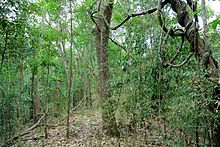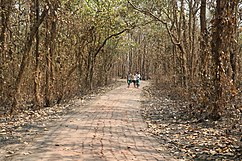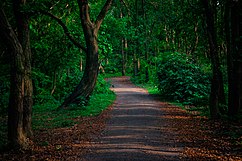Seasonal tropical forest

Seasonal tropical forest, also known as moist deciduous, semi-evergreen seasonal, tropical mixed or monsoon
Distribution

Seasonal (mixed) tropical forests can be found in many parts of the
- In the Indochina
- Eastern Java monsoon forests
- Wallacea Forest
- Brahmaputra Valley semi-evergreen forests
- Mondulkiri Province, Cambodia
- Cat Tien National Park, Vietnam
- Khao Yai National Park and Huai Kha Khaeng Wildlife Sanctuary, Thailand
- Northern Australia: Cape York Peninsula (Queensland), Arnhem Land (Northern Territory), The Kimberly (Western Australia)[2] [3][4][5]

- In the Americas
- Atlantic forestsof Brazil
- Central and eastern Panama: with Barro Colorado Island especially well studied [6]
- In Africa
- Coastal Gambia to eastern Ghana
- Coastal
Climate
The climate of seasonal forests is typically controlled by a system called the Intertropical Convergence Zone (ITCZ), located near the equator and created by the convergence of the trade winds from the Northern and Southern Hemispheres. The position of these bands vary seasonally, moving north in the northern summer and south in the northern winter, and ultimately controlling the wet and dry seasons in the tropics.[7] These regions appear to have experienced strong warming, at a mean rate of 0.26 degrees Celsius per decade, which coincides with a global rise in temperature resulting from the

Structure
As with
Characteristic biology
The fauna and flora of seasonal tropical mixed forest are usually distinctive. Examples of the biodiversity and habitat type are often well described for National Parks in:
- Africa represented by:
- the northern part of Korup National Park in Cameroon (central region)

- the Upper Guinean forests (West Africa)
- Asia represented by Indochinaregion)
- Pacific region: including the Queensland forest reserves
- Central American wildlife is well represented in:
- Costa Rica e.g. Corcovado National Park
- the Soberanía National Park in Panama.
- South American flora listed and represented in Rio Doce State Park
References
- ^ Mongbay: Types of tropical forest (accessed 21 March 2017)
- ^ Beard, J.S.; Keneally, K.F. (1987), 'Rainforests of Western Australia'. In 'The rainforest legacy: Australian national rainforests study'. Special Australian heritage publication series 7(1), pp. 289–304
- ^ Webb, L. J. (Leonard James); Tracey, J. G. (John Geoffrey) (1982), An ecological survey of the monsoon forests of the north-western region of the Northern Territory, Australian National Parks and Wildlife Service
- ^ Russell-Smith, Jeremy; Dunlop, Clyde (1987), The status of monsoon vine forests in the Northern Territory: a perspective. In 'The rainforest legacy: Australian national rainforests study. Special Australian heritage publication series 7(1)
- ^ Stanton, J.P.; Fell, David. G. (2005). "The rainforests of Cape York Peninsula". Rainforest CRC – via National Library of Australia.
- ^ Leigh EG, Rand AS, Windsor DM (Eds. 1983) The ecology of a tropical forest. Seasonal rhythms and long-term changes. Oxford University Press 468 pp.
- ^ NWS JetStream – Inter-Tropical Convergence Zone. Srh.noaa.gov (5 January 2010). Retrieved on 28 March 2013.
- ^ PMID 15212087.
- ^ Ya-Jun Chen, Kun-Fang Cao, Stefan A. Schnitzer, Ze-Xin Fan, Jiao-Lin Zhang, Frans Bongers (2015) Water-use advantage of lianas over trees in seasonal tropical forests. New Phytologist, 205[1]: 128–136
See also
- International Tropical Timber Organization (ITTO)
- List of tropical and subtropical moist broadleaf forests ecoregions
- Trees of the world
- Tropical dry forest
- Tropical rainforest
- Tropical vegetation


